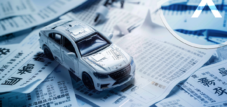Published on: March 31, 2025 / update from: March 31, 2025 - Author: Konrad Wolfenstein

Capital injection for Chinese banks: An analysis in the context of customs disputes and economic challenges - Image: Xpert.digital
How China's government wants to save the economy with capital injections
A billion -dollar answer to complex problems
The Chinese government takes a remarkable measure to strengthen its financial system and boost the economy: it injected billions of US dollars in four of its largest state banks. This capital injection, which was around $ 71.6 billion, took place in the middle of a number of economic challenges that the Middle Kingdom plagues. This included slowed-down economic growth, a battered real estate sector, persistent deflation pressure and the increasing economic pressure from US tariffs.
The capital sprayer aimed to improve the lending of these banks. The government hoped that the banks would give more loans to companies and private individuals due to the strengthened capital base, which in turn would boost investments and consumption and thus stimulate the economy as a whole.
However, it is important to emphasize that this measure should not be regarded as an isolated solution. The Chinese economy faced a variety of problems, and the capital injection was only part of a more comprehensive strategy to master these challenges. Critics expressed doubts as to whether the measure alone would be sufficient to stimulate the economy.
Suitable for:
- More than just a damper on growth in China? Between plan and market: The Chinese economic miracle in crisis?
Details of the capital injection: scope, mechanism and goals
The capital injection, which was officially confirmed on March 30, 2025, concerned the following four large banks:
- Bank of Communications
- Bank of China
- China Construction Bank
- Postal Savings Bank of China (PSBC)
The total amount was around $ 71.6 billion, which corresponded to around 520 billion Yuan. It is worth noting that the 66 billion euros mentioned in some reports were in a similar area due to exchange rate fluctuations.
How did the capital injection work?
The capital increase was realized by private placements by stocks among investors. The Chinese Ministry of Finance played a central role as the main investor and acquired stocks worth 500 billion yuan. This measure took place shortly after the government's announcement to spend special government bonds worth 500 billion Yuan in order to strengthen the capital of the country's largest state lenders. The Ministry of Finance confirmed that the issue of these bonds was used to finance the capital injection.
Why was the core capital Tier 1 strengthened?
The main purpose of the capital injection was to strengthen the capital of the banks, to improve the quality of their balance sheets and to boost lending in order to keep the economy running. A special focus was on the filling of the core capital Tier 1 of the banks. The core capital Tier 1 is a crucial indicator of the financial strength of a bank, since it is made up of the highest quality capital components, such as: B. the maintenance profit and the expelled capital. It serves as a buffer to catch losses and ensure the stability of the bank.
The emphasis on the core capital Tier 1 indicates that the government not only aimed at the fulfillment of minimum regulatory requirements, but rather wanted to achieve fundamental financial solidity of the banks. This could indicate that the government anticipated potential future stress for the banking system due to the economic uncertainties.
China's economic challenges in 2025: a multi -layered problem
The capital injection did not take place in the air empty. It was a reaction to a number of economic challenges that China had to cope with in 2025:
Slowed economic growth
The Chinese government had set itself the goal of around five percent economic growth in 2025. In view of the weak growth, however, analysts had asked to quickly equip the country's large banks with fresh capital. Although China achieved growth of around 5 % in 2024, the basis for sustainable recovery was not yet consolidated, since both domestic and foreign demand were weak and the real estate sector continued to contain challenges. Reaching the 5 percent growth goal for 2025 was a significant challenge that required measures such as the capital injection to the banking sector in order to boost the economic activity.
Real estate crisis
Chinese banks fought with a considerable amount of necessary loans in the middle of a continuing slump in the real estate sector. The capital increase aimed at strengthening the lending, which in turn could support the struck real estate sector in the country. However, the situation in the real estate sector remained tense. Reports indicated that real estate continued to be a significant burden on the economy, since prices and investments had not yet reached a low point, even though the speed of the decline had slowed down. Various perspectives on the real estate market in 2025 ranged from potential stabilization in the second half of the year to expectations of a continuing drop in prices and no broad relaxation. The oversupply remained a serious challenge.
The real estate crisis was therefore an essential factor that affected the health of the Chinese banks and the overall economy, which in some cases made the capital injection a measure of risk minimization in the event of further deterioration in this sector.
Suitable for:
- More than just numbers: What the current developments in China's economy really mean - What's ahead?
US tariff
Since February 2025, Chinese exports have been launching US tariffs, which were significantly increased again in March 2025. It was believed that the establishment of capital buffers could help the banks to cope with the risks of the Chinese economy in the middle of the escalating trade conflict with the United States. The US tariffs thus contributed to the economic counter-winds that China was exposed to, since it potentially impaired export-oriented companies and increased the risk of loan losses, which required stronger banking capitalization.
Deflation pressure
The government tried to combat deflation pressure. Reports confirmed the presence of deflation in China in early 2025, with consumer reference fell below zero and the producer prices also decreased. This trend had continued over several quarters. Deflation can weaken consumption demand and company investments and thus continue to slow down economic growth. Deflation prints tightened the challenges of weak economic growth and the real estate crisis, which was potentially less profitable for companies and increased difficulties in repaying loans and thus impairing the banks.
Suitable for:
How the capital injection should work: mechanism and expected effects
The capital injection should essentially work through two mechanisms:
- Strengthening the banks' capital base: This would enable banks to increase their lending without endangering their financial stability. A well -capitalized bank can absorb capital losses without reducing their lending.
- Course of lending: The increased lending should help to boost the country's economy, which is in a slowdown. In particular, she should support the country's battered real estate sector.
It was expected that the capital injection would enable banks to better use the real economy and to support the constant and long -term economic development of the country.
New approaches to restore trust in households and companies
However, the political decision -makers were still faced with the challenge of restoring the trust of households and companies that were still hesitant when spending. There was also the risk of deterioration in credit quality, since banks tried to expand consumption credit.
Although the capital injection aimed to boost the lending, its effectiveness in promoting economic recovery depended on whether trust was restored and whether the increased lending actually led to expenses and investments without a significant deterioration in credit quality.
The role of the US tariffs in China's economic landscape: an additional stress factor
The US tariffs that were raised to Chinese imports represented an additional stress factor for the Chinese economy. On March 4, 2025, the tariffs were increased to all Chinese imports from 10 % to 20 %. This was done as part of the International Emergency Economic Powers Act (IEEPA). With the alleged failure of China, the increase was justified to combat the fentanyl crisis sufficiently.
It is important to note that certain exceptions could apply, for example for goods that were in the transit before February 1, 2025, as well as specific provisions of the HTSus chapter 98.
It was expected that the tariffs would burden the Asian-Pacific economies, including China. Analysts expected the tariff to dampen Chinese growth through lower exports, investments and other consequences. However, there were different assessments of how much tariffs would affect Chinese growth.
China's broader economic context in early 2025: a mixed picture
In order to fully understand the effects of the capital injection and the US tariffs, it is important to take into account the broader economic context of China in early 2025:
- Chinese industrial production rose by 5.9 %in the first two months of 2025, which was a slight slowdown compared to December.
- Real retail sales rose by 4.1 %in the first two months in the year, which showed a certain improvement, but was still weak compared to the rates before pandemic.
- The Chinese consumer fuel fell below zero in February 2025, which indicated deflation pressure. The producer prices also fell on. China had defined a relatively low inflation target of around 2 % for 2025, which indicated an expectation of continued low inflation.
- The real estate investments remained in the negative area in the first two months of 2025. The prices for new and existing houses continued to drop in February in the month comparison, although the decline in some cities slowed down. Oversupply and weak consumer confidence continued to burden the housing market.
Overall, the Chinese economic image showed a mixed picture in early 2025. There were some positive signs, such as B. the growth of industrial production and retail sales. However, there were also considerable challenges, such as B. deflation and the real estate crisis.
Expert opinions on capital injection: a predominantly positive assessment
Analysts and economists generally expressed themselves positively about the capital injection:
- Northeast Securities analysts assumed that the recapitalization plans would help the lenders to increase their capital buffers and to cope with the burdens of wealth quality. They pointed out that falling interest rates and declining profits have increased capital pressure on the banks.
- HSBC Global Research believed that the capital injection would benefit the resistance of the Chinese banking system.
- S&P Global Ratings explained that the capital injections would give the big banks more opportunities to finance the country's growth in the face of the headwind through tariffs and to improve their loss of loss in view of the profit pressure. They expected large banks to continue to prioritize areas with fresh capital, such as including financing, advanced production and green energy.
However, some experts warned that the capital injection alone may not be sufficient to stimulate the Chinese economy. They emphasized the need to restore consumers and companies' trust and to address the underlying problems in the real estate sector.
Suitable for:
Historical parallels and teachings: A look into the past
It is helpful to put the current capital injection in the context of historical parallels:
- In the past, China has made significant efforts to restructure the banking sector, especially in the late 1990s to cope with high amounts of needy loans. This included the issue of special government bonds and the supply of capital to the “large four” state banks. The costs of these previous restructuring were considerable and possibly achieved a significant percentage of GDP.
- During the financial crisis of 2008, governments worldwide used bank rescues and capital injections to stabilize their financial systems. Examples of this are the US Troubled Asset Relief Program (TARP).
These historical examples show that state interventions in the financial sector are a common instrument in times of economic burden. However, they also show that the success of these measures depends on a wide range of factors, including the general economic mood and the effectiveness of other accompanying political measures.
One step in the right direction, but not the whole solution
The capital injection to the four large Chinese banks is a significant and multi -layered reaction to the current economic challenges of the country. It aims at short notice to improve banks' capital resources and increase its ability to lending. This could potentially contribute to the stabilization of the battered real estate sector and support broader economic recreation.
However, there are still considerable uncertainties regarding the long -term effectiveness of this measure. The continuing deflation pressure and the deeper problems in the real estate sector could continue to impair the willingness of companies and households to borrow and investments. In addition, the growing pressure by US tariffs represents an external load, which could possibly reduce the positive effects of the capital injection.
The experience from previous banking recapitalization in China and international reactions to financial crises and trade wars indicate that state interventions in the financial sector are a common instrument for coping with crisis. However, the success of these measures depends on a broad spectrum of factors, including the general economic mood and the effectiveness of other accompanying political measures.
The further development of the Chinese economy is largely determined by the interaction of these factors. While the capital injection is an important measure to strengthen the financial system, it is probably not a sole solution for the complex economic challenges that China is confronted with in 2025. The government's ability to restore trust, contain the deflation and alleviate the negative effects of the US tariffs will be crucial for the future economic development of the country.
Suitable for:
Your global marketing and business development partner
☑️ Our business language is English or German
☑️ NEW: Correspondence in your national language!
I would be happy to serve you and my team as a personal advisor.
You can contact me by filling out the contact form or simply call me on +49 89 89 674 804 (Munich) . My email address is: wolfenstein ∂ xpert.digital
I'm looking forward to our joint project.
















